Initial Structure Design and Optimization of an Automotive Remote Head-Up Display
Abstract
:1. Introduction
- (1)
- The design index is proposed according to the current industry AR-HUD standard.
- (2)
- A method of initial AR-HUD structure design based on the Rodrigues rotation formula is proposed, and combined with the characteristics of the off-axis triple inverse structure, the problem of structural occlusion in the optimization process is solved.
- (3)
- We design an example according to the above method and analyze the design results.
2. Basic Theory and Design Objective
2.1. Design Principle
2.2. Design Parameter Analysis
3. Proposed Methods
3.1. Initial Structure Design Based on the Rodrigues Rotation Formula
3.2. Anti-Occlusion Optimization Method Based on the Off-Axis Triple Inverse Structure
4. Simulation Design and Results
4.1. Design Example
4.2. Image Quality Analysis
5. Conclusions
Author Contributions
Funding
Institutional Review Board Statement
Informed Consent Statement
Data Availability Statement
Conflicts of Interest
References
- Guo, W.; Yan, D.; Liu, T.; Zhang, Z. Technical Challenge and Solution for Vehicle-Mounted AR-HUD Mass Commercial Application. In Proceedings of the International Conference on Optoelectronic and Microelectronic Technology and Application, Nanjing, China, 20–22 October 2020. [Google Scholar]
- Park, H.S. In-Vehicle AR-HUD System to Provide Driving-Safety Information. ETRI J. 2013, 35, 1038–1047. [Google Scholar] [CrossRef]
- Chen, Y.; Xu, J. Application of Augmented Reality in Automobile Design. Design 2021, 34, 82–85. [Google Scholar]
- An, Z.; Xu, X.; Yang, J.; Qiao, Y.; Liu, Y. Design of Augmented Reality Head-up Display System Based on Image Semantic Segmentation. Acta Photonica Sin. 2018, 38, 77–83. [Google Scholar]
- Wiesner, C.A.; Ruf, M.; Sirim, D.; Klinker, G. 3D-FRC: Depiction of the Future Road Course in the Head-Up-Display. In Proceedings of the IEEE International Symposium on Mixed and Augmented Reality (ISMAR), Nantes, France, 9–13 October 2017. [Google Scholar]
- Huang, X.; Hu, S.; Tang, G.; Yang, P.; Xu, B.; Zhang, G. Optical structure design of automotive head-up display with long-distance imaging. J. Appl. Opt. 2019, 40, 894–900. [Google Scholar]
- Chen, X.; Cao, Y.; Xue, J.; Ren, J.; Wang, B.; Wu, S. Optimal Design of Optical Module for Double Freeform Head-up Display System. Laser Optoelectron. Prog. 2022, 60, 360–366. [Google Scholar]
- Wei, S.; Fan, Z.; Zhu, Z.; Ma, D. Design of a Head-up Display Based on Freeform Reflective Systems for Automotive Applications. Appl. Opt. 2019, 58, 1675. [Google Scholar] [CrossRef] [PubMed]
- Zhang, Y.; Su, Z.; Pan, H.; Chen, X.; Zhang, W. Optical Design and Tolerance Analysis of Freeform Automotive Head-up Display. Acta Photonica Sin. 2020, 49, 44–55. [Google Scholar]
- Bremers, A.W.; Yöntem, A.Ö.; Li, K.; Chu, D.; Meijering, V.; Janssen, C.P. Perception of Perspective in Augmented Reality Head-up Displays. Int. J. Hum. Comput. Stud. 2021, 155, 102693. [Google Scholar]
- Jazar, R.N. Theory of Applied Robotics: Kinematics, Dynamics, and Control, 2nd ed.; Springer: Cham, Switzerland, 2010. [Google Scholar]
- Chen, T.; Wu, Y.; Song, S.; Li., S. Design and Alignment of Folded Off-Axis Three-Mirror Optical System. Laser Optoelectron. Prog. 2021, 58, 355–361. [Google Scholar]
- Luo, Q.; Zhang, D.; Niu, X. Optical Design of Off-axis Three-mirror System with Wide Field. Infrared 2017, 38, 14–18. [Google Scholar]
- Zhuang, S.; Qian, Z. Modulation Transfer Function, 1st ed.; China Machine Press: Beijing, China, 1981; pp. 256–264. [Google Scholar]

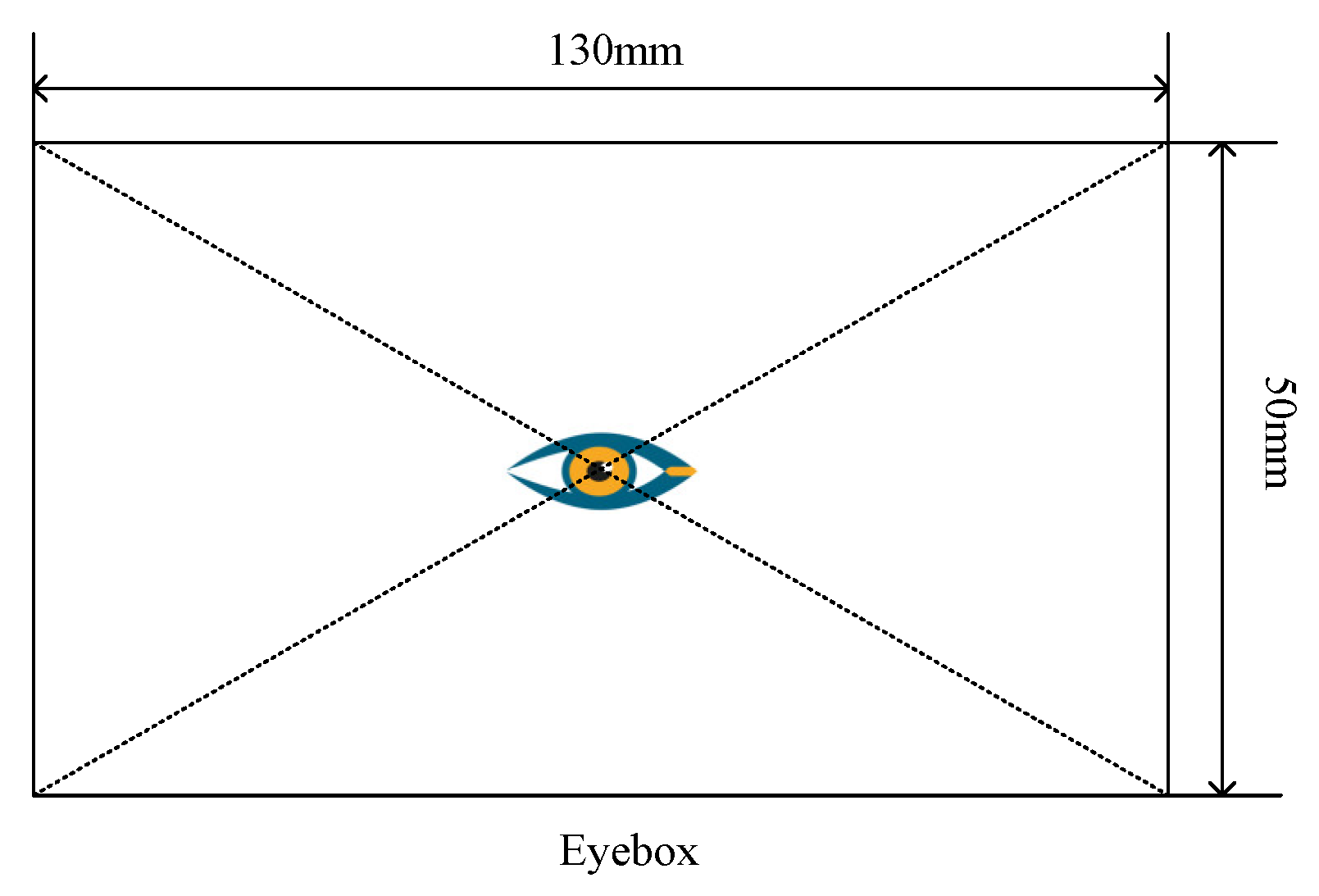

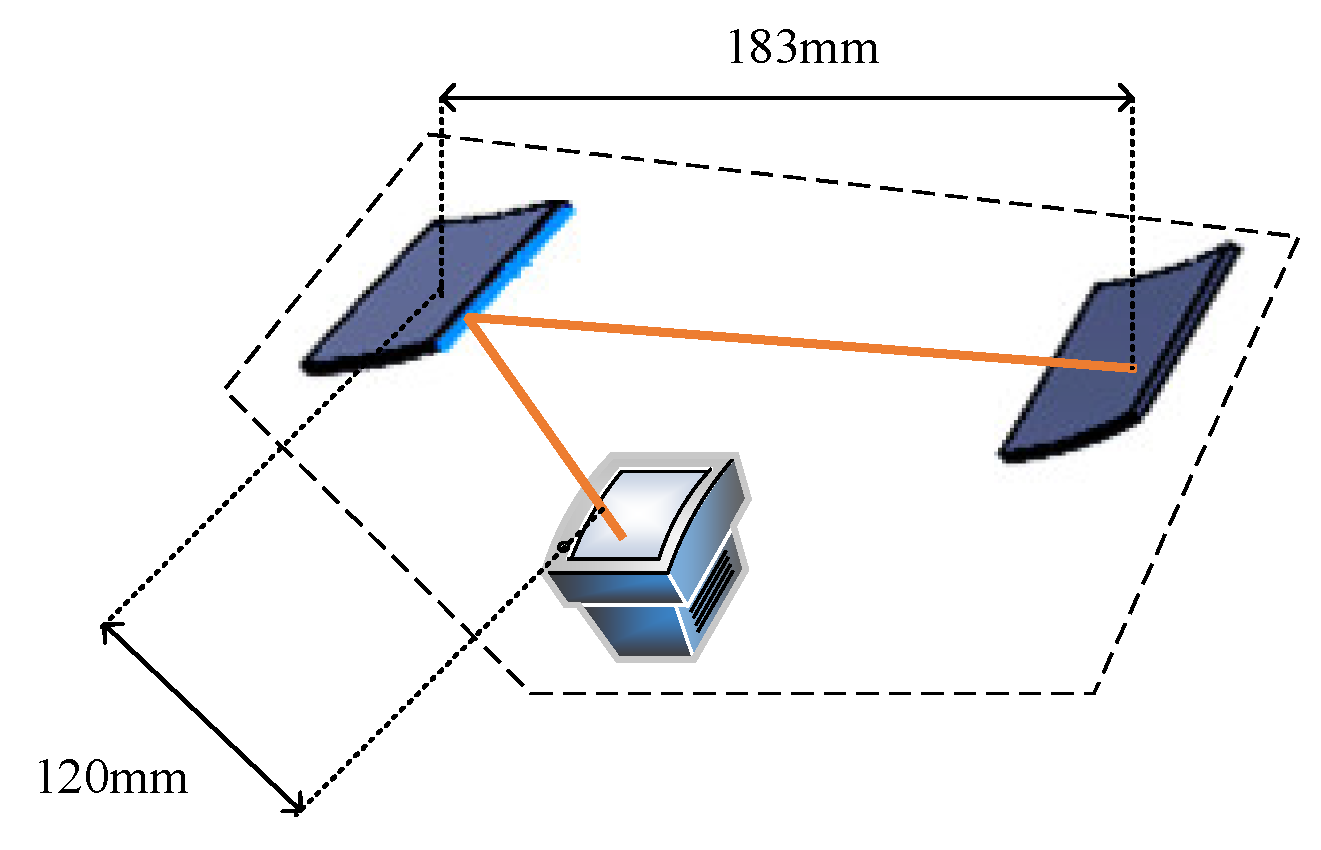


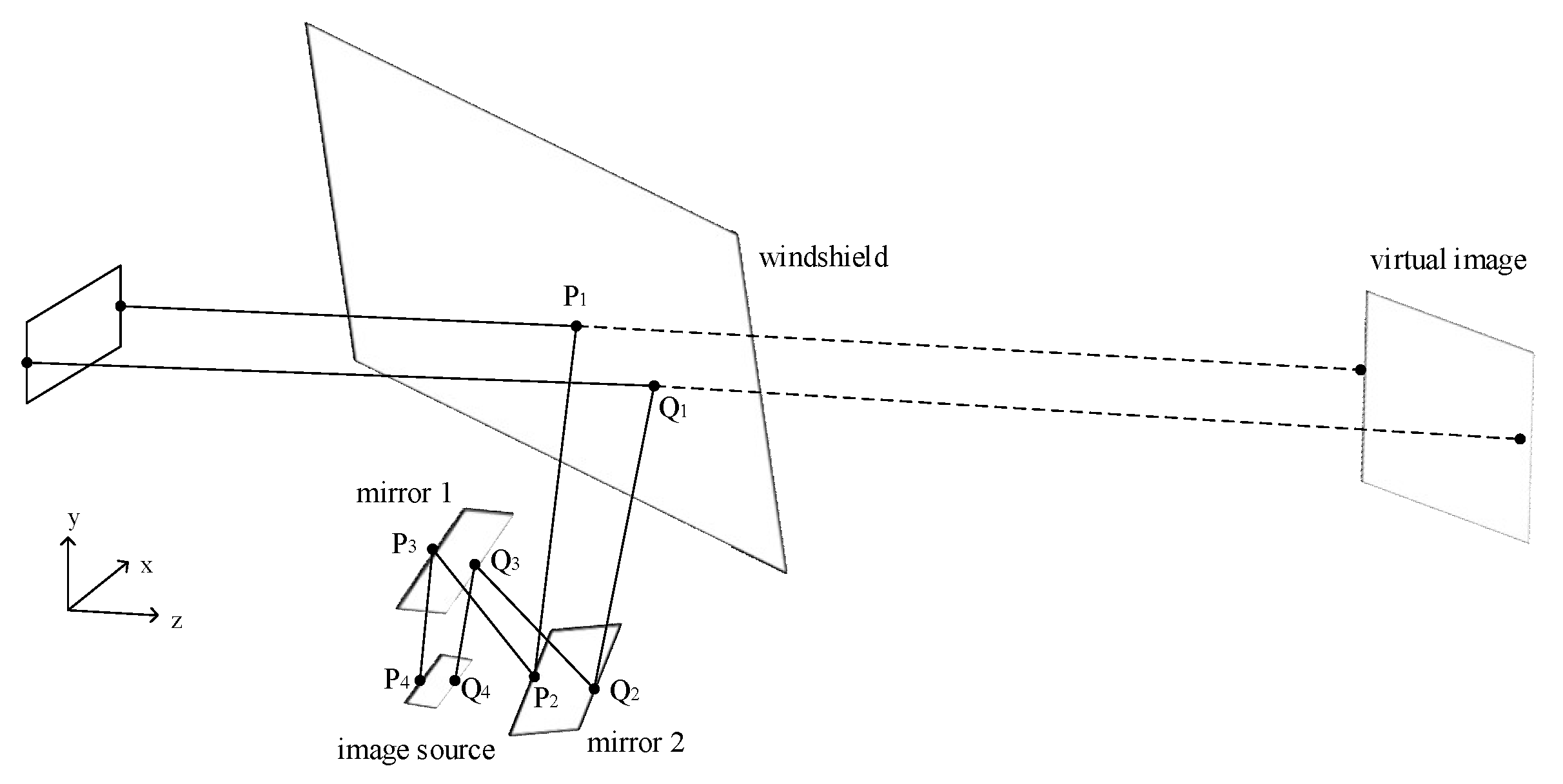
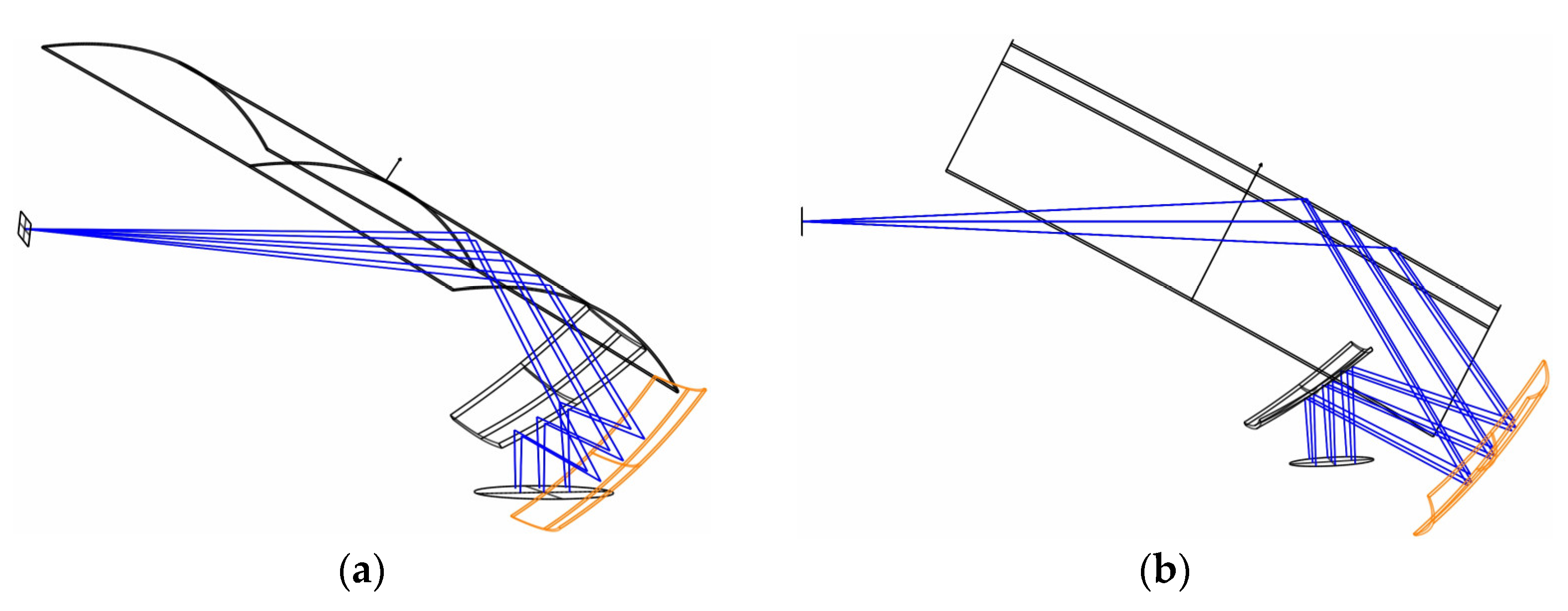
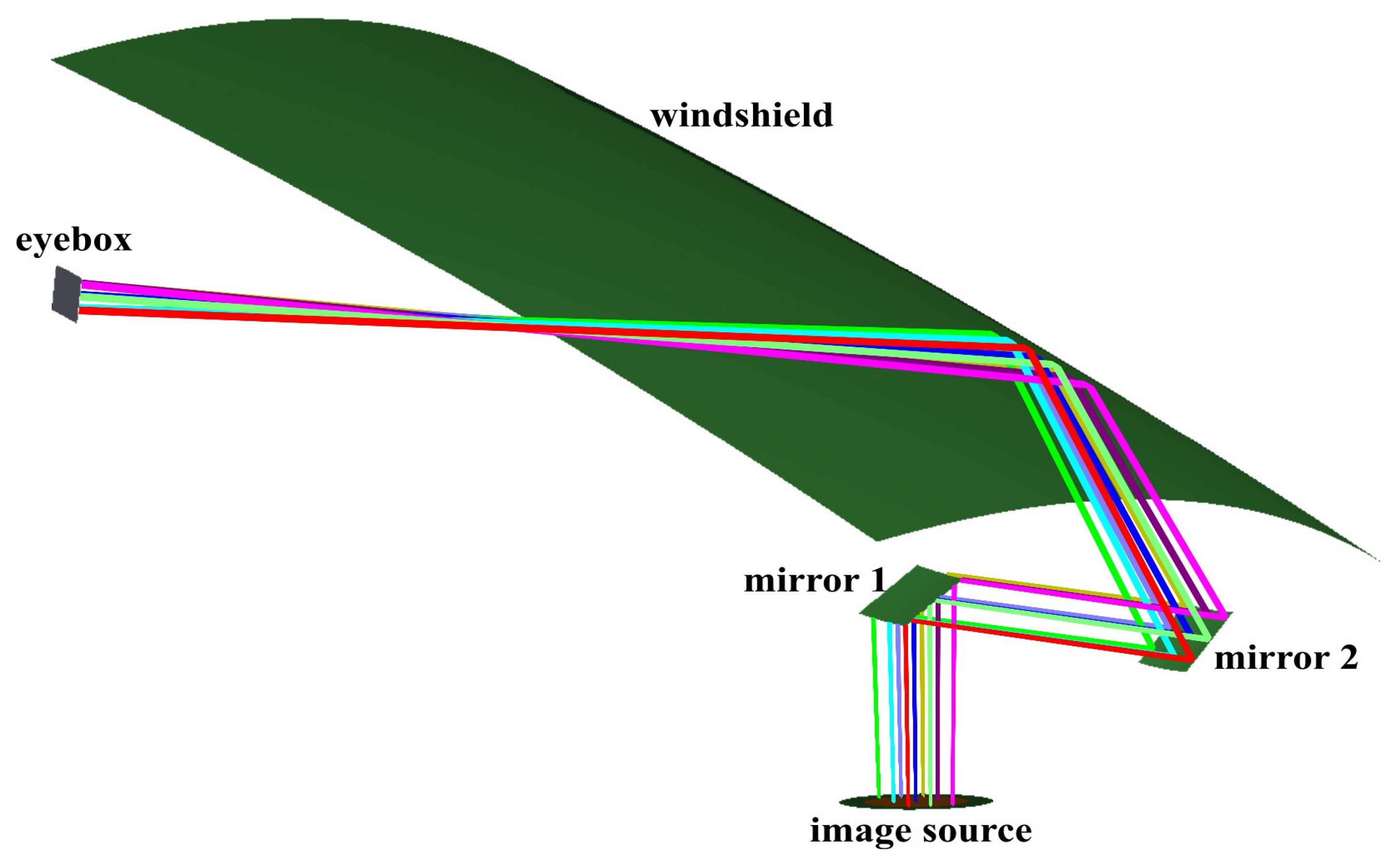



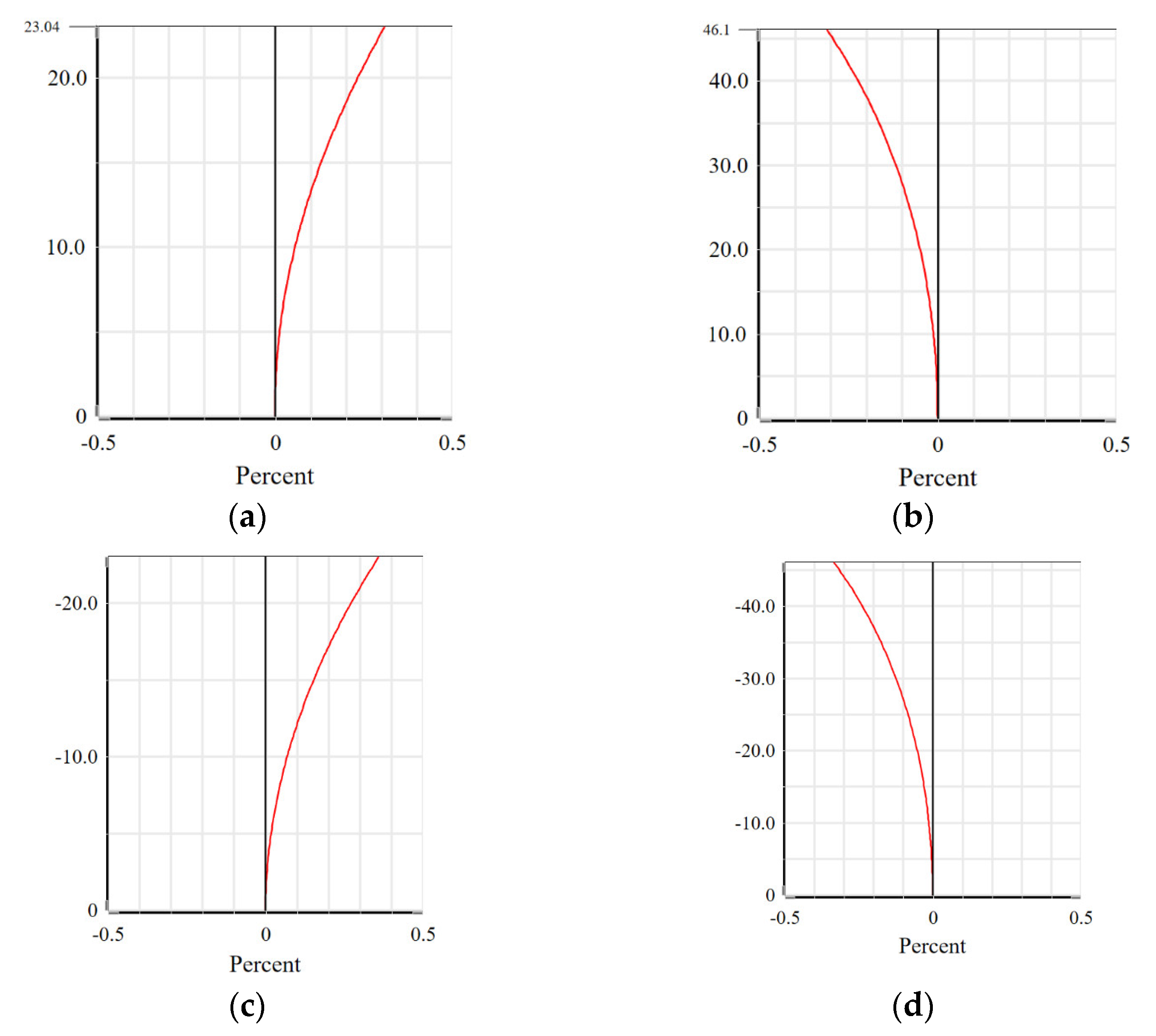

| HUD System Parameter | Value |
|---|---|
| Wavelength (mm) | 486–656 (visible light) |
| Virtual image distance (m) | 7.5 |
| Angle of field (°) | 10 × 5 |
| Eyebox (mm) | 130 × 50 |
| Source image size (mm) | 92.08 × 42.04 |
| Virtual image space MTF | >[email protected] lp/mm |
| Distortion (%) | <2 |
| Radius (mm) | Conic | (X1Y0) | (X0Y1) | (X2Y0) | (X1Y1) | (X0Y2) |
|---|---|---|---|---|---|---|
| −7526.66 | −2.789 | 2.308 | −3.569 | −7.601 | 2.430 | −3.564 |
| Surface | Radius (mm) | Interval (mm) | Tilt x (°) | Tilt y (°) |
|---|---|---|---|---|
| M1 | −12,494.98 | −140.64 | −39.229 | 0.223 |
| M2 | −106.487 | −154.320 | −12.525 | 3.225 |
| Windshield | −7526.66 | 286.972 | 61.836 | −6.956 |
| Surface Type | Radius (mm) | Conic | X2Y0 | X1Y1 | X0Y2 | X3Y0 | X2Y1 | X1Y2 |
|---|---|---|---|---|---|---|---|---|
| Extend polynomial | −12,494.98 | 1.000 | 3.479 | - | −0.661 | −0.006 | - | - |
| X0Y3 | X4Y0 | X3Y1 | X2Y2 | X1Y3 | X0Y4 | |||
| −0.078 | 0.412 | - | −0.084 | - | −0.107 |
| Surface Type | Radius (mm) | Conic | X2Y0 | X1Y1 | X0Y2 | X3Y0 | X2Y1 | X1Y2 |
|---|---|---|---|---|---|---|---|---|
| Extend polynomial | −106.487 | −1.026 | 51.925 | −0.107 | 48.937 | −0.036 | 0.055 | −0.005 |
| X0Y3 | X4Y0 | X3Y1 | X2Y2 | X1Y3 | X0Y4 | |||
| −0.057 | 0.218 | - | −0.500 | - | −0.268 |
Disclaimer/Publisher’s Note: The statements, opinions and data contained in all publications are solely those of the individual author(s) and contributor(s) and not of MDPI and/or the editor(s). MDPI and/or the editor(s) disclaim responsibility for any injury to people or property resulting from any ideas, methods, instructions or products referred to in the content. |
© 2023 by the authors. Licensee MDPI, Basel, Switzerland. This article is an open access article distributed under the terms and conditions of the Creative Commons Attribution (CC BY) license (https://creativecommons.org/licenses/by/4.0/).
Share and Cite
Ye, Y.; Chen, H.; Wang, Z. Initial Structure Design and Optimization of an Automotive Remote Head-Up Display. Appl. Sci. 2023, 13, 9649. https://doi.org/10.3390/app13179649
Ye Y, Chen H, Wang Z. Initial Structure Design and Optimization of an Automotive Remote Head-Up Display. Applied Sciences. 2023; 13(17):9649. https://doi.org/10.3390/app13179649
Chicago/Turabian StyleYe, Yu, Huaixin Chen, and Zhixi Wang. 2023. "Initial Structure Design and Optimization of an Automotive Remote Head-Up Display" Applied Sciences 13, no. 17: 9649. https://doi.org/10.3390/app13179649




